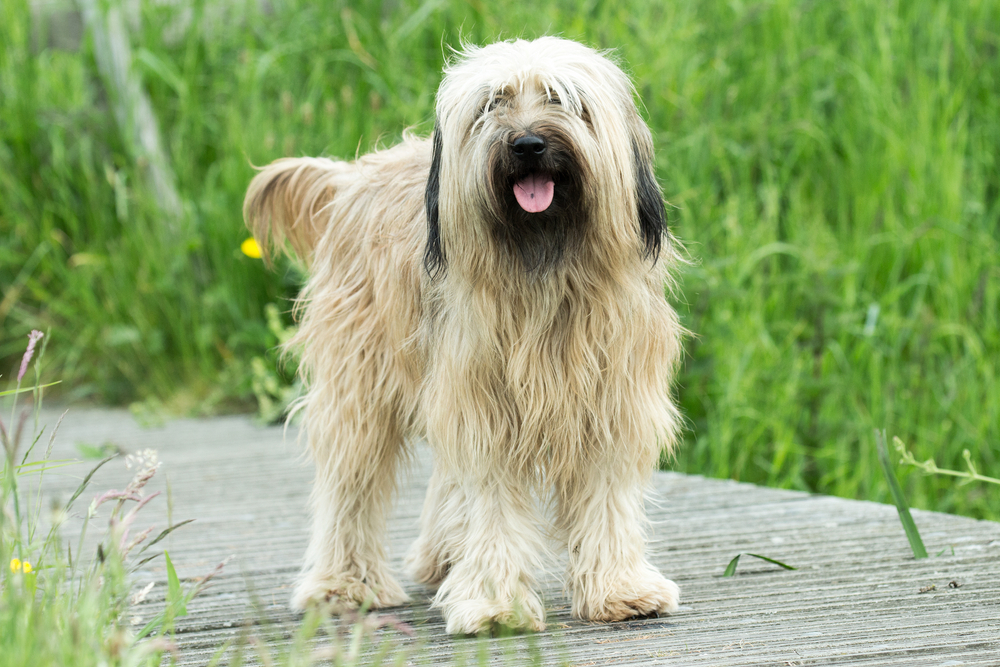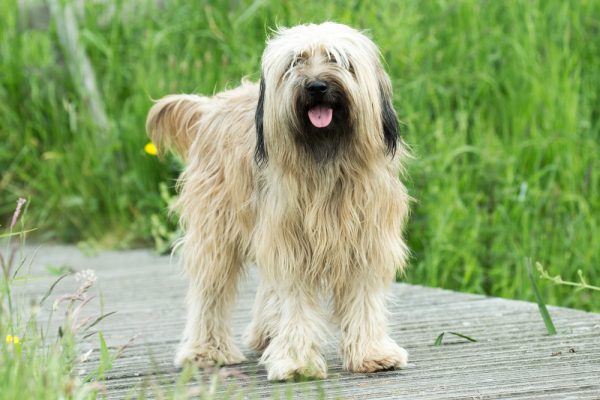Click Below to Skip Ahead
Also known as the Catalonian Sheepdog, the Catalan Sheepdog is an uncommon breed in the US, but if you’ve ever met one, then you’ve been lucky to meet such a genial dog breed. This is a herding breed, as the name implies, and while they have full beards and mustaches like other sheepdog breeds, the Catalan doesn’t have fur covering its eyes, although this trait is common in other sheepdog breeds. The goofy, sweet appearance of this breed matches its temperament!
Breed Overview
Height:
17.5 – 21.5 inches
Weight:
35 – 40 pounds
Lifespan:
12 – 14 years
Colors:
Fawn, sable, grey, black
Suitable for:
Active families, homes with large yards, farms and ranches
Temperament:
Gentle, happy, versatile
The Catalan has a sturdy, athletic build that allows it to serve as an effective herding dog. This is a Pyrenean-type breed, but it is much smaller than its Great Pyrenees cousin. While they are sweet and gentle enough to be household dogs, the Catalan is built to withstand tough environments and is a hardy working dog. Like many herding breeds, the Catalan is happiest when it has a job, especially tasks that involve herding or guarding.
Catalan Sheepdog Characteristics
Catalan Sheepdog Puppies
As a herding breed, Catalan puppies are natural herders, often showing herding behaviors while still very young. This is a high-energy breed, so you can expect high-energy puppies. However, the Catalan is an intelligent and highly trainable breed, so you can expect a pup that is quick to learn, especially with consistent training. This breed isn’t recognized by most of the large dog fanciers’ clubs, but there are some breeders of the Catalan in the US. It may be difficult and expensive to find a pup, though, due to the limited number of breeders.
Catalan Sheepdog Breed Origin & History
The Catalan originated in Catalonia, Spain, and while it was developed for the purposes of herding and guarding livestock, this breed has also been used throughout its history for jobs like search and rescue, police work, and even guard and messenger dogs during times of war.
By the 1970s, the number of Catalans left in the world was extremely low, so supporters of the breed began working on a breeding program to save the breed from extinction. Although that program has been in place for around 50 years, the Catalan is still considered to be a rare breed.
 Temperament & Intelligence of the Catalan Sheepdog
Temperament & Intelligence of the Catalan Sheepdog
When it comes to geniality, the Catalan is a wonderful breed option. This breed is known for its gentle demeanor, along with its strong work ethic and instincts. They are extremely energetic dogs that need daily exercise and will thrive if given a job. While many sheepdog and livestock guardian breeds are highly independent, the Catalan is quite social by comparison. This breed loves spending time with its people, as well as its charges, whether that be livestock, children, or other pets.
Are These Dogs Good for Families? 👪
Yes, the Catalan is known for being excellent with children. It is a protective breed, so it may not be tolerant of visitors, but with introductions, they typically warm up quickly. They naturally take to children to protect them, but as a herding breed, they also tend to try to herd anything and everything they can. This means that you may have a dog that tries to herd your children everywhere, which can cause some issues.
Does This Breed Get Along With Other Pets? 🐶 😽
Since this is a breed that was developed to deal with livestock, the Catalan is a great option to have around livestock animals. They may view cats and other dogs as predators and threats, though. Generally, the Catalan is not a suitable breed for multi-dog homes. However, early socialization can make them more accepting of being around other dogs, which is likely necessary if your Catalan is doing farm or ranch work.
Things to Know When Owning a Catalan Sheepdog:
Food & Diet Requirements 🦴
Catalans need to be fed a high-quality diet that is formulated to meet WSAVA guidelines, which your vet can help you select. If your dog is extremely active throughout the day or is a working dog, then they may benefit from a sport or working dog formula food. These foods are more calorie-dense than other dog foods, and they usually contain more protein and fat to help maintain a healthy body weight and muscle mass in active dogs.
Exercise 🐕
Daily exercise is a necessity for the Catalan, and as a high-energy breed, they’re not satisfied with a basic walk once or twice per day. Be prepared to provide moderate to high levels of exercise every day. This is not a suitable breed for people who aren’t active because this dog benefits from activities like running and hiking. The ideal exercise for a Catalan is activities that provide a use for their strong instincts, like herding work, cani-cross, treibball, and agility work.
Training 🎾
The Catalan is a highly trainable breed that aims to please, but proper training still requires consistency and routine. It’s important to note that the instinct to herd is not likely to be addressed by normal obedience and basic training. You will need to work specifically on discouraging this behavior if your Catalan is attempting to herd children or other pets in the home. In some cases, the help of a professional trainer may be necessary when dealing with strong instincts.
Grooming ✂️
Interestingly, this breed has a double coat only on the back half of its body. The outer coat is rough and can be wavy or straight, while the undercoat is thick. When this breed sheds, it usually sheds the front half of its coat first, then sheds the back half of the body after the first half is finished. Because of their coat type and likelihood of spending a lot of time outdoors, brushing multiple times per week is recommended to prevent mats, tangles, and debris from being caught in the coat.
In some cases, daily brushing may be necessary. Pet bath wipes and waterless shampoo can be used to maintain the health and cleanliness of the coat between baths. Keep the ears clean and the nails trimmed short, making sure to trim the back dewclaws. The nails on the back dew claws are often overlooked and may grow into the pads if not kept trimmed.
Health and Conditions 🏥
- Dental disease
- Skin infections
- Patellar luxation
- Hip dysplasia
- Progressive retinal atrophy
- Glaucoma
- Epilepsy
Male vs. Female
Since this is a rare breed, it’s difficult to determine consistent differences between the sexes, especially when it comes to temperament. Like most dog breeds, males are likely to be larger than females, but this breed is a solidly medium-sized dog, so the variation in size is not particularly significant. Females may be easier to train and may mature more quickly than males, but they are also likely to be more independent and less loving than males.
3 Little-Known Facts About the Catalan Sheepdog
1. They Originated in the Catalan Pyrenees Mountains
It was in the Catalan Pyrenees Mountains that this dog originated, and it is where they worked as flock drivers and guardians.
2. They Aren’t Recognized by the AKC
While not being recognized by the AKC, they were recognized by the UKC on July 1, 2006.
3. They May Have Been Brought to Spain by the Romans
It is possible that these dogs were brought to Spain by the Romans, who invaded Spain thousands of years ago.

Final Thoughts
The Catalan Sheepdog is a wonderful dog breed that is versatile and hardy, making it ideal for both home life and working as a farm dog. Daily exercise should be provided, as well as enrichment exercises, like puzzles, to keep your Catalan active. Without enough exercise and enrichment, this breed is likely to become anxious, destructive, and noisy.
While livestock guardians and herding dogs aren’t always recommended as house pets, the Catalan makes a great house dog, as long as it’s provided with plenty of stimulation every day. This is an excellent companion for highly active people and homes with active children.
Featured Image Credit: Anne Zwagers, Shutterstock







